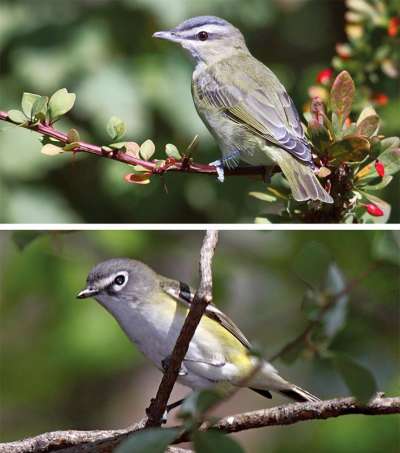
Red-Eyed Vireo (top) - Voice: Robin-like, rich and fruity. Pace and duration: Steady and energetic, sometimes incessant (for hours). Phrases: Usually three syllables.
Blue-headed Vireo (below) - Voice: Slightly thinner and weaker than red-eyed vireo, somewhat forced from the “back of the throat.” Pace and duration: Slower, more reticent; the blue-headed often stops singing (even in the morning). Phrases: Includes more two-syllable phrases, notably a cute, recognizable see-ya (often at the end of each iteration).
Some weighty and persistent questions in the North Woods: Black spruce or red spruce? Green frog or mink frog? Red-eyed vireo or blue-headed vireo?
Not that the two vireos look alike. What makes them difficult is that they sound alike, and we often hear vireos before we see them. Taking on the challenge of telling these two vireos’ songs apart will not only help you learn more about these species, it will also provide a lesson in how to analyze and recognize confusing vocalizations among birds in general.
First, a review of the basics. Begin by learning the songs of common species, which can serve as points of reference. A scarlet tanager sounds like an American robin with a sore throat, for example, and a rose-breasted grosbeak sounds like a highly caffeinated American robin with a richer voice.
Using catchy mnemonic phrases can also help – whether they come from your field guide or your own brain. A black-throated green warbler sings a buzzy, memorable zee zee zah zoo ZEET! But one birder I know prefers, I’ll have mine on WHEAT! She even makes the vague connection from wheat to moldy bread to the green on the warbler. Hey, like I say, whatever works. (By the way, if those sonograms – basically oscilloscope displays of bird vocalizations – work for you, more power to ya’. My brain doesn’t like them.)
David Sibley described the song of another vireo – the warbling vireo – as a rapid, run-on, husky viderveedeevider veedeeviderVEET. If that seems like a mess or otherwise doesn’t work for you, try saying this (as fast as you can): if-I-could-see-you-I-would-seize-you,-and-I-would-squeeze-you-’til-you-SQUIRT! Does a warbling vireo say anything resembling those words? Nope. But it works for many birders, mostly because the duration of the phrase and its energy and cadence match a warbling vireo’s performance.
Which brings us back to our teachable moment with blue-headed and red-eyed vireos. Again, a good point of reference is the American robin, which sings rich, repeated two- or three-syllable phrases: churry-up churry-oh, cheer-up cheery-oh. The vireos sing similar, sweet, slower versions of this; they sort of say their name and offer a running commentary on your bird-finding skills: veerio, here-I-am, look-way-up, in-the-tree, see-me? No, you-don’t.
So first, get a general sense of the vireo’s song – the essentials of its phrases and sweetness. (You’ll be able to practice after you’re done reading.) Next comes the skill-building: discern subtle differences in voice, pace, and phrases. Yes, these distinctions can be hard to learn. But the payoff is more than wisdom in the woods; I find the journey – slowing down, losing for a moment the wonderful mess of diversity in our woods, adopting a singular focus – worthy of almost any walk outside. With time, you’ll notice the differences I point out here in the table.
Now that you’re ready to go outside and practice, here’s a way to cheat. In June and July, the red-eyed vireo can be a reference bird. Widespread in hardwoods, they sing – often nonstop – throughout the nesting season. If you’re in hardwoods (and sometimes mixed woods), even in suburbia, you are not far from a red-eyed vireo. Blue-headed vireos prefer nesting in softwoods.
Oh, by the way, if you would like an even more demanding vireo challenge, consider the Philadelphia vireo. (No, being from Philly won’t help you recognize its accent.) Philly vireos breed in early- to mid-successional deciduous woods and edge habitats across boreal Canada and parts of northern New England and New York. They sound very much like red-eyed vireos, but slower and weaker. The similarities are so strong that I confuse them with red-eyes about half the time. Which is fine – birds are a journey in lifelong learning.

